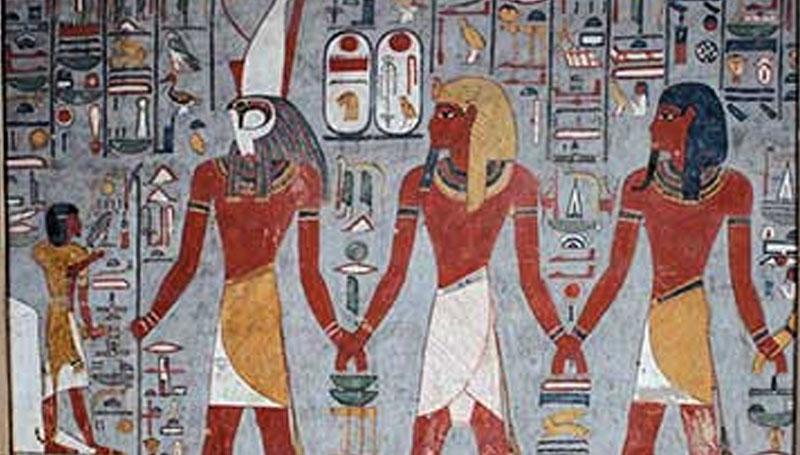Who was Ramses I?
Ramses I was born into a famous military lineage from the Avaris region of northern Egypt and was not intended to be pharaoh.
Paramesu was his name, and he had a brilliant military career in Egypt. During Horemheb’s reign, the last emperor of the eighteenth dynasty, he rose to tremendous heights of prominence, becoming a general (1539-1292 BC).
Paramesu was a talented man who knew how to quickly gain the pharaoh’s trust, which led to him being chosen vizier (chaty), the state’s second most powerful position.
Ramses I, the founder of a dynasty
Horemheb had to appoint an heir over the years because he had not been able to produce male progeny. He considered Paramesu to be the most qualified person to lead Egypt’s destiny.
Despite the fact that he was no longer a young man, the general had a son, Seti, who ensured dynastic continuity. As a result, when Horemheb died, Paramesu took his place on the throne as Ramses I.
However, his reign was short, since he only reigned for sixteen months before passing (supposedly from an ear infection) at the age of fifty. His son Seti I succeeded him, and Seti I had a son, the future Ramses II.
After his death, the aged pharaoh was buried with all the ritual and majesty that a pharaoh of ancient Egypt deserved in the tomb dug for him in the Valley of the Kings (KV16).
Because there was no time to finish it before the King’s death, the tomb (which was recently restored and opened to the public) was tiny in size, and only the burial chamber was decorated.
The priests and the transfer of mummies
Giovanni Battista Belzoni, an Italian explorer and adventurer, entered Ramses I’s tomb in 1817 but was unable to locate his mummy. So, where could the King be?
The body of Ramses I enjoyed the tranquility of his tomb for approximately two hundred years before ancient Egypt was plunged into a period of great political upheaval; the Valley of the Kings suffered countless pillages.
During those years, the priests of the twenty-first dynasty were in responsibility of transporting the royal mummies from one location to another in quest of safety from tomb thieves.
And Ramses I’s mummy was no exception. It was allegedly initially moved to tomb KV17, his son Seti I’s tomb, which is said to be the most beautiful in the Valley. Ramses II, his grandson, would follow him there.
This, however, would not be the fate of these three generations of pharaohs. The mummies of the three sovereigns were then moved to Queen Ahmose-tomb Inhapy’s from the seventeenth dynasty, and then to Pindejem II’s tomb at Deir el-famed Bahari’s cache.
Despite the fact that the famed cache yielded a huge number of royal mummies, Ramses I was not one of them. What had happened to him, then?
The mummy of Ramses I travels to the United States
A remarkable collection of royal mummies was discovered many years ago. Not by archaeologists, but by a family of tomb robbers known as the Abd el Rasul.
In 1871, the Abd el Rasuls sold a remarkably well-preserved mummy to Dr. James Douglas, who then sold it to the Niagara Falls Museum in Ontario (described as a “museum of monsters and curiosities of nature”), where it was displayed as the mummy of the legendary Queen Nefertiti, wife of the heretic pharaoh Akhenaten.
The return of Ramses I to Egypt
The royal mummy of Ontario was kept at the museum for 130 years, until the museum fell bankrupt in 1999. It was donated to the Michael C. Carlos Museum at Emory University in Atlanta in 2001.
The mysterious mummy was subjected to different tests at this institution, and academics from the University eventually announced that they could say with certainty that it was Ramses I’s mummy.
The careful and expensive mummification process that the mummy had undergone convinced the specialists that it was a genuine mummy.
A CT scan taken at Emory Hospital’s Department of Radiology revealed advanced mummification procedures, including the presence of enormous amounts of resin (a highly expensive substance) in the skull. The mummy was also submitted to radiocarbon dating, which determined that it belonged to the New Kingdom.
As a result of all of this, experts concluded that the mummy in the Michael C. Carlos Museum was, without a doubt, that of Ramses I.
The Egyptian authorities, led by Zahi Hawass, the Secretary General of Egypt’s Supreme Council of Antiquities at the time, did not waste any time in requesting the return of the remains. No objections were raised by the American institution.
The mummy of Ramses I was then placed in a plain wooden box covered with the Egyptian flag and brought to the Land of the Nile, where he was received with all the pomp and circumstance that a pharaoh deserves.
Since 2004, the mummy of the founder of one of Egypt’s most powerful dynasties has been kept in a special room at the Luxor Museum.
 The African History Truly African
The African History Truly African

